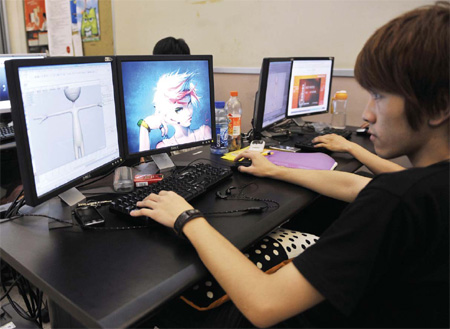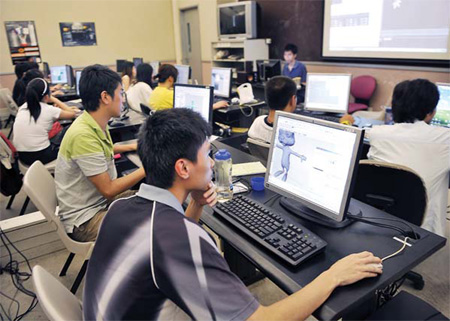Focus
Twist in the tale for cartoon studios
By Duan Yan (China Daily)
Updated: 2010-08-17 13:27
 |
Large Medium Small |

A designer draws a character for a new cartoon being made at the Global Digital Creations, one of China's most experienced animation studios, which has done work for Disney and DreamWorks. Qi Jieshuang / for China Daily |
Is China's booming animation sector heading for a happy ending? Duan Yan reports from Shenzhen.
Yuan Qi's passion for animation began early.
She took drawing lessons when she was just 5 and since high school dreamed of one day recreating the magic of DreamWorks and Disney cartoons she grew up watching.
Now 27, she knows there is still a long way to go before the dream comes true.
"It'll probably take another two generations before the industry in China can catch up with Japan and the United States," said Yuan, who studied for two years in Germany before starting work in 2007 as a set designer in Shenzhen, Guangdong province.
Like many in her field, she is struggling to make a living, despite the fact that Chinese studios produced a combined total of 170,000 minutes of footage last year and has already surged past that figure this year.
Even with billions of yuan in government subsidies and policies designed to boost the animation industry, analysts say the country is still short on talent and creativity, as well as a business model that can sustain the sector's growth.
During the first five months of this year, 221 Chinese-made cartoons (more than 270,000 minutes) were produced for domestic television channels, according to the State Administration of Radio, Film and Television (SARFT).
However, the output was met with apprehension by studio bosses, some of whom feel such mass production could erode quality.
"It will be terrible if it continues like this," said Liu Chungang, secretary-general of the Beijing Animation and Game Industry Alliance. "This is not a comedy but a tragedy for Chinese animation."
He explained that Japan's animation industry, one of the most established in the world, produced just 80,000 minutes of footage last year, while France made 40,000.
"How many of the cartoons produced in China were of good quality? Probably not even 1 percent," Liu said.
Within the domestic industry, 2004 is referred to as "year one", as it was when the SARFT limited the use of foreign-made cartoons by television stations. New rules stated that Chinese-made animations should make up at least 60 percent of all cartoons broadcast.
Two years later, the authority banned foreign-made cartoons from being aired between 5 pm and 8 pm, and extended it to 9 pm in 2008.
The move led to a boom in animation studios, from about 120 in 2002 to more than 10,000 in 2009, show figures from the State Administration of Industry and Commerce. Most are small firms that provide cheap content to fill the gaps left by the block on imports.
Liu Chuangzhi, a producer for Animation Starry Sky, which is on China Central Television's children's channel at 11 pm, recently revealed at an animation forum that his show gets all its cartoons for free.
None of the companies charge, he explained, because they can collect up to 2,000 yuan ($295) in government subsidies for every minute that is aired.
Most of these companies are housed in government-backed animation bases, which offer free rent for up to three years.
According to Cai Daming, director of the Yijing National Animation Base in Shenzhen, almost 100 such properties are under the management of the Ministry of Culture, the SARFT and the General Administration of Press and Publication. (The Ministry of Culture's website states the number is 78 but an official spokesman admitted that figure is out of date.)
"You have to provide at least one original cartoon to set up your office here," said Cai. "Rent can be as much as 60 yuan per square meter a month in some places. Here, it's just 10 yuan. Some companies move out as soon as the rent exemption is over."
In addition to the bases, more than 23 provinces and municipalities also offer subsidies to studios.
Changing work flow
For three decades, Shenzhen firms have traditionally received a large portion of the work outsourced by foreign production houses, including from Japan and Hollywood.
Yet, although it has brought in revenue, it has done little to stimulate creativity.
In 2005, one of the most experienced animation studios, Global Digital Creations, produced Thru the Moebius Strip, a science fiction movie based on the comic book by French artist Jean Giraud. It was the first feature-length cartoon made entirely in China.
Although dubbed in English and targeted at the Western market, company manager Cao Hui, who was head of distribution at the time, said she faced immense difficulties in trying to get the film shown in theaters in the US. (Critics complained that it was more visually stunning than a good example of storytelling.)
After five years of work by 400 artists and an investment of 130 million yuan, the movie eventually generated just 3 million yuan at box offices in China.
Despite its relative failure, the movie proved the studio is capable of producing large-scale, three-dimensional animation of international quality, said Cao, whose team also makes cartoons for Bratz, a line of dolls sold in the US.
"If the movie had been successful we could have produced another one by now," she said, adding: "The movie came out too early. Many audiences in China used to think animation is just for kids."
Taking on outsourced work may be good for the bank balance and training staff in advanced techniques but it also comes at a price.
"It's not easy to manage creativity with production," said Cao, whose firm is now focusing on producing original stories due to the shrinking workload offered by Japanese and American companies hit by the global financial crisis.
Bosses at Xing-Xing Digital, a Beijing-based studio that produced animation and special effects for Hollywood hits like Fantastic Four and Madagascar, admitted they are also looking to a domestic market that is far from swamped with standout performers.
The country's first and largest cartoon company, Shanghai Animation Film Studio, was opened in 1957, during the golden era of China animation, and has produced many hit shows and gained international recognition. One of its films, Uproar in Heaven (Da Nao Tian Gong), which is based on the classic Journey to the West (Xi You Ji), won numerous awards in the 1960s.
The most successful Chinese-made cartoon of recent times is Pleasant Goat and Big Big Wolf (Xi Yang Yang Hui Tai Lang), which has appeared on more than 70 domestic channels since its debut in 2005.
"We believe we succeeded because we tell the story differently," said Shao Haowen, a spokesman for Creative Power Entertaining, which makes the show. "We want to tell funny stories, not make old-fashioned educational cartoons. The stories reflect the world through kids' eyes."
Cai at the Yijing Animation Base agreed and said too many producers still rely on China's wealth of historic storylines for inspiration.
"But audiences want something modern, relevant and interesting," he said. "No one wants to learn about history when they go to the (movie) theater to watch a cartoon."
"The majority of cartoons made in China are aimed at children watching at home," added Shao, "and many producers don't pay much attention to the stories because they think kids won't notice."
Other major challenges to making money from cartoons are the limited distribution channels and rampant copyright infringement, according to Wang Lifeng, president of Xing-Xing Digital.
To prove his point about the latter, Shao admitted that the success of the money-spinning Pleasant Goat television show, which has so far spawned two movies, has been tinged by the fact that "80 percent of products on sale that use the cartoon's trademark image do not have our brand licensing approval".
Although Creative Power Entertaining is turning a profit, smaller companies that want to make quality cartoons need to be looking at long-term profits.
Liu Bei, a cartoon director at Tinkkid, a small Beijing studio that makes shows for the Kaku children's channel, said his company is resigned to sacrificing short-term gains through distribution and merchandise, and is instead focused on telling good stories.
"It's like we're putting up a great building and leaving the selling to our partners," he said, continuing his construction analogy to explain how he felt animation companies using outsourced work are "experienced bricklayers who haven't learned how to build a house yet".
"We all have our learning curves," he added.

One of the artists' workshops at the Global Digital Creations' base in Shenzhen. Wages in the industry are still low and many leave the job for better salaries with game design companies. Qi Jieshuang / for China Daily |
Drawing comparisons
That learning curve is not only for companies but also the artists they employ. However, experts say animation training in China is expanding way too fast to ensure quality, while the standard of wages is low.
More than 440 universities offer majors in animation for more than 400,000 students, yet officials with the Ministry of Education said few are able to find work after graduation.
On the section of the ministry's website about the national college entrance exam, animation is listed as one of 10 "high risk majors" that have the highest unemployment rate and lowest salaries.
As well as production, Global Digital Creations also offers 10-month training courses at centers in Shenzhen, Guangzhou, Chongqing and Shanghai.
"Many of our students are college graduates with animation majors who are not competent to start working at studios yet," said company manager Cao. "Many need classes in other subjects, so they are not able to start working immediately after graduation.
"Only a few will start working for us after they've completed the course. The others will go to work for different animation companies."
Cartoonist Yuan Qi, who studied in Germany as "most colleges in China don't have good animation tutors", said most people leave the industry after a few years to earn better salaries in advertising or as video game developers.
The average annual income for the animation sector is 70,000 yuan, which is expected to rise to 90,000 yuan by 2012, said Cai Lin, a media analyst with China Investment Consulting's industry research center. He declined to elaborate on how this figure is devised.
"Most people I know only earn about 30,000 to 40,000 yuan a year," said Yuan, who dismissed the research center's estimate. "There are animators in some cities whose monthly income is just 2,000 yuan. This job is as cheap as selling cabbages in the street."
Huang Yangbo, a 26-year-old animation director in Shenzhen, said his first job in Changsha, Hunan province, was for 800 yuan a month and followed a six-month unpaid internship.
"I feel like I'm lost," he said, admitting that he fears for the industry as long as the emphasis is on making profits. "The culture here in Shenzhen is all about business. I don't know about other places. Maybe Beijing or Shanghai is better."
Making just 3,000 yuan a month in Shenzhen, a city with a relatively expensive cost of living, Yuan said the only thing that is keeping her going is her passion for animation.
"I love it too much to quit now," she said.
